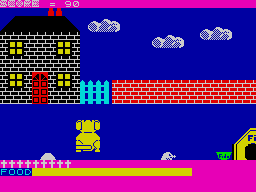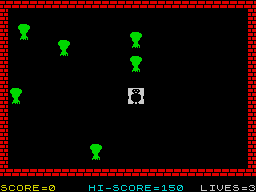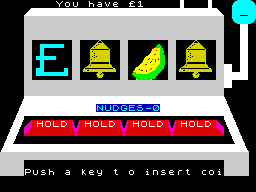FIDO is a dog with an Impossible Mission, side swiping the naughty moles with that rigid tail of his.

Producer: Firebird
Memory Required: 16/48k
Retail price: £2.50 — it’s a steal!
Language: megabasic (it’s a very good basic though)
Authors: Anon
We’ve had some fun this month extracting the Michael from the Software Editor. Playing on his kind, easy going temperament we handed him a copy of Firebird’s Don’t Buy This and persuaded him that it was a collection of megabrill games. At first he seemed less than convinced so we produced a few review sheets extolling its virtues. Graeme finally clinched it by telling him that he hadn’t learned to appreciate the more subtle aspects of some Spectrum games. Almost convinced, Spencer the Corpulent then phoned Firebird — so we all dashed upstairs to listen in on the extension...
‘We have a copy of your latest release here but it seems to have five games all on one tape, surely there must have been a mistake?’
‘No there’s no mistake, at least not as far as those games are concerned.’
‘Why is it called Don’t Buy This when it seems such great value?’
‘Who did you say you were?’
‘Jeremy Spencer from CRASH’
‘Are you serious?’
‘What? about being from CRASH?’
‘No, about the games.’
‘Well of course I am.’
‘Are you the new Software Editor? The guy that used to sell yellow wellingtons for horses, the ones you filled with water?’
‘Well... er... yes’
‘... and now you own an Amstrad and a lamb that answers to the name of Ernie?’
‘Yes’
‘... and a dog that chews empty wine bottles?’
‘well yes but what...’
‘... you are serious!’
‘Yes of course but why call the cassette “Don’t Buy This”?’
‘It wasn’t meant to be called Don’t Buy This but the type-setters made a mistake.’
‘What was it meant to be called?’
‘Oh it’s been called all sorts of things, lots and lots of different names but since we’ve had so many inlay cards printed it seemed to stick you see.’
‘Fair enough I suppose, perhaps you could give me the names of the authors? I can’t find any credits.’
‘Too right, John... they said they wanted to be kept out of it, out of the limelight I mean, and for that matter perhaps you could keep Firebird’s name out as well... please.’
‘Well that’s very modest of you.’
‘All part of the image you know.’
BBRRRRRRRRRRRR
Race Ace is a very straightforward racing game, in fact its simplicity is one of its strongest features because you can get stuck in straight away. The player steers one of nine little cars round a fixed track, the others being controlled by the computer. Any one of 250 speeds can be selected for a race of four or more laps. At first I thought the game a little limiting because it only has one track until I realised that by using the simple trick of going backwards a completely new race could be run — unfortunately the other cars persisted in going the wrong way. The graphics are very simple but this is necessary in order to follow the fast action that the game provides. A particularly admirable feature is that no matter what happens to the player’s car, like colliding with another car, or with the kerb, or indeed with anything, it suffers no damage. This means that since your car can’t be damaged you won’t have to keep going back to the start as other race games tend to insist you do. Once your car pulls out into the lead then the race is over: this neatly avoids the tedium you encounter in games like Full Throttle of having to stay ahead once you are.
FIDO is a dog with an Impossible Mission, side swiping the naughty moles with that rigid tail of his.

This game requires the player to position the dog, Fido, so that when he sits down and wags his tail he batters little moles to death. The moles keep popping up at the bottom of the screen. This may sound easy to do but you must be careful not to exhaust the little pooch, his energy decreases as he moves across the screen so you must guide him to his feed bowl to boost his energy. The game gets harder still when you consider the action of the birds, they just fly across the screen but because Fido is larger when seated than when standing the birds can crash into his head and kill him. To avoid this awful end Fido can duck (another sort of bird), you do this by making him stand up. To make the game harder still the program seems to have been written so that every now and then Fido dies for absolutely no apparent reason — very realistic.
Best Graphics of the Year award goes to WEASEL WILLY. The mushroom shaped things are actually trees and the shape in the middle is Willy. Unfortunately the camera caught him just as he was flashing, otherwise you would see an elegant character...

This has simply got to be the best version of Weasel Willy available. The object of the game is to guide what looks like a bear round the screen without touching the trees, which are cunningly placed at random. Should you collide with any object then a superb message comes up saying ‘YOU’VE BLOWN IT’ and you lose a life. If you manage to steer the bear round the park then just when you least expect it the screen will re-draw with more trees all in different places. You continue in this way until you have exhausted all of your lives, which is inevitable because nobody is that good. The program has some neat touches, two in fact. The first is a league table and the second lets the player re-define the keys, this feature is cleverly offered every time you re-start the game just in case you feel like a change. I particularly liked the way the bear flashes. What happened to the Weasel?
Fido 2 is probably better known under its other title of Puppy Power. The gameplay in this powerful follow up to the immensely successful Fido remains the same, ie to batter the moles with your tail, this version is a great deal harder though, as befits a sequel. Firstly, although the programmers have left the diminishing energy bar in, they have cunningly left the food bowl out so Fido starves to death. This game has more screens than before: rather than just a simple street scene we now have a cave and beach scene as well. What makes Fido 2 such a winner is the way Fido is chased by little thingies. If they catch him while he’s trying to batter a mole then he will die. The pursuing objects vary from screen to screen; in the first screen we have a purple bust of a chap with a very long nose, the other screens have flowering scotch thistles, ashtrays with smoking cigarettes, smashed up sandcastles and finally toy pistols. All of the backdrops have doors of some kind, but the amazing thing is that no matter what you do you won’t be able to get through any of them. Should you find the game too hard the programmers have built in a feature which allows you to flick through the five screens and admire the graphics.

If you’re unhappy with the ‘nudges’, just break into BASIC and edit line number 880 and change the random number in brackets to whatever you would rather have! If you reckon the machine hasn’t given you a nudge for some time, just break in and type GOTO 880 — CRASH, the mag that gives playing tips with your captions!
Everybody knows how to play this so perhaps I should point out the features that can be used to advance your enjoyment of the game. Firstly there is an accountant telling you how much money you have left out of your original pound. Every so often, about once in a thousand pulls, you can take advantage of the Nudge feature, the hold facility is offered a little more frequently. On winning you will be asked if you want to gamble, another screen puts this offer to reality and two numbers will flash, the first slightly higher than your initial win, the second will be nothing, that’s what I call gambling. One problem with many fruit machine programs is the sheer speed at which everything happens, not with this game, this is nice and ever so slow, the player can sit back and be sure of missing nothing.
Control keys: Z/M left/right X to brake but it rather depends on
the game
Joystick: none on one; others allowed the Kempston but didn’t say why
Keyboard: ours had funny little rubber keys that squished up when you pressed
them this tended to make rapid game play difficult but that didn’t matter since
rapid game play isn’t required
Use of colour: some of them had colour and those colours looked very...
coloured
Graphics: fairly uncomplicated some were actually very uncomplicated
Sound: I don’t think there was any, apart from the odd bleep
Skill levels: not so much skill as persistence
Lives: by and large, taken as a whole, there were too many
General rating: I’m told it’s great.
| Use of computer | ( 6)% |
| Graphics | (17)% |
| Playability | (10)% |
| Getting started | (27)% |
| Addictive qualities | (76)% |
| Value for money | (700)% |
| Overall | (39.333333)% |
N.B. Using the old CRASH system of having the overall figure as a strict average of the other marks, it looks much better that way. One other point I feel that I should raise is that the Headitor tells me that because this package has five games all on one tape tradition demands that the percentages must be given in brackets. This seems a shame because readers might get the idea that this means they are minus points, but that would be silly as only accountants put negative numbers in brackets and boring accountants don’t read CRASH anyway, do they? (Answers, on an postcard please, to J Spencer CRASH)